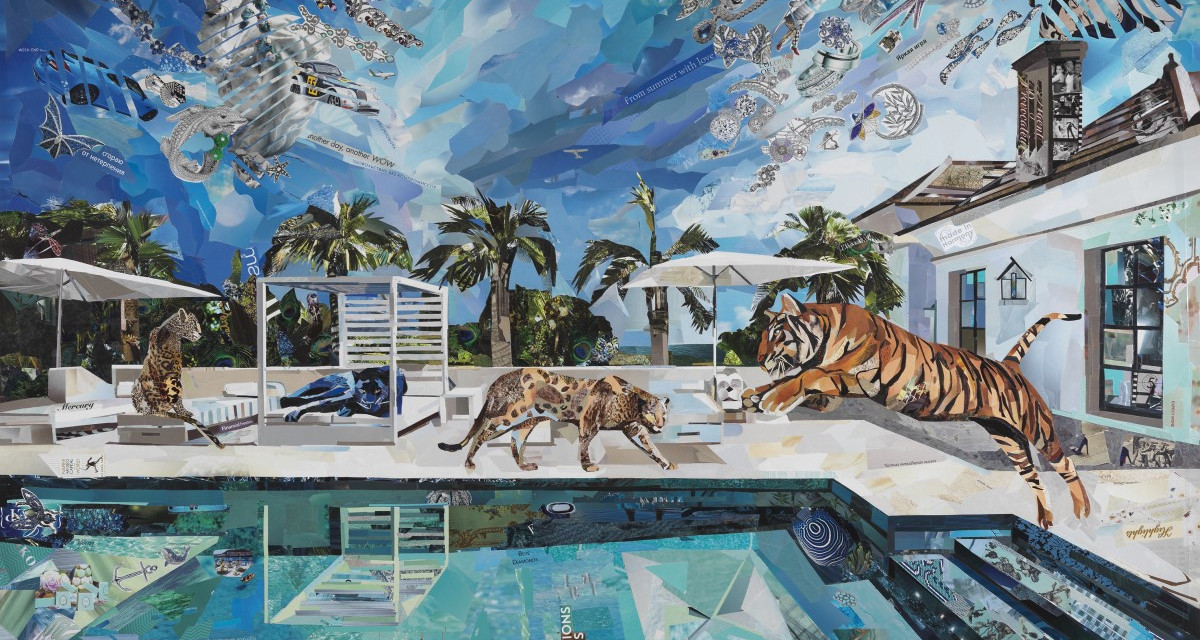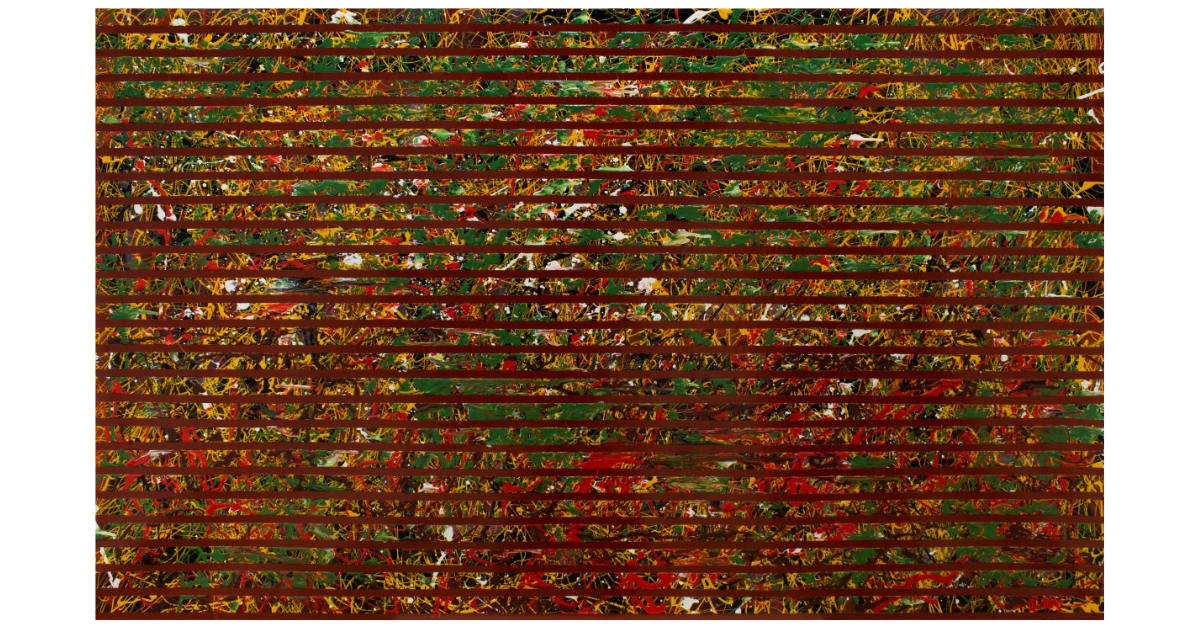St. Tropez, 2015, collage on paper, 100 x 150 cm. Serenity series
Daria Usova, Official Artist of the Principality of Monaco, Shares Her Story
Promotion
William Burroughs, a literary American icon, once called the genre of collage a “flexible hieroglyph language of juxtaposition.” It looks like Daria Usova has mastered this language to perfection. To her, collage-work is tantamount to entering the realm of creative freedom, imagination, and discovery. And also, the realm of mystery. After all, the technique of collage resembles and mimics our reality that is similarly fragmented and patch-like, clashing together diverse and oftentimes incompatible impressions and events. Subsequently, with the passing of time, our memory endows them with personal layers of meanings and weaves them into a fabric that becomes uniquely our own.

Mars Portal 1. 2022, 130 x 200 cm, collage on paper. The Environments series
Daria has been working in her favourite collage technique for almost twenty years. She invented the method herself in 2003, when still an art student, and then patented it under the name of Pieces Art. Since early noughties, she has artistically collaborated with major glossy magazines, such as GQ, Наrреr’s Ваzааr, L’Officiel, Vogue, Men’s Health and was involved in art projects for such brands as Martini and Mazda. Her works can be found in private, museum and corporate collections, such as Fondazione Imago Mundi, established by the fashion designer and art collector Luciano Benetton, (with Christo, Laurie Anderson, Frank Gehry, Zaha Hadid acting as earlier contributors to the collection); in the Prince Albert Foundation (Monaco), the Guggenheim Museum Foundation (New York), BSL Hotel Metropole Monaco, Credit Mobilier de Monaco, Société Générale Private Banking, Barclays Private Banking, A.P.T. Gallery (Hong Kong), and many others.

Dolce & Gabbana, 2021, collage on paper, 100 x 100 cm, private collection
The Prince of Monaco Albert II honoured her exhibition with His visit several years ago and then commissioned the double portrait of His children in Daria’s signature technique. Also, a few years ago, her collage portraits featuring members of the House of Grimaldi graced the covers of various Monégasque periodicals. Prince Fuad of Egypt acquired several works from Daria’s “Egyptian” series for one of his residences in Switzerland.
Daria also created collage portraits for such famous fashion designers, as Paul Smith, Chantal Thomass, Zandra Rhodes, Dolce & Gabbana. Pop-singer Brian Ferry and actor Vincent Perez have also been captured in portraits by the artist. “And how do you work? Do you have any assistants?” Daria laughs in response: “No, no assistants, I am old-fashioned, I do everything myself and by hand. So, no gadgets, no assistants, no computer design – only my own vision and artistic skill.”
Talking of her method, Daria upcycles out-of-date, used and thrown-away glossy magazines, and transforms them into her own ironic artistic commentaries on contemporary situation. “I am a child of 1990-2000s, when glossy fashion industry ruled supreme, producing these magazines, the artefacts of our time,” relates the artist. Eventually, her meticulous collages, resembling painted images, return to where they came from – the very glossy magazines they were made from. The cycle comes full circle (so, yes, it is very likely that you might find some fragments from this Mayfair Times issue in her next creation!)
When explaining how she discovered her own signature technique, Pieces Art, Daria recollects: “Strangely, it came to me in a dream when I was still a student working on a course project whose main subject was reconstruction. Upon waking up, I immediately made the image of John Lennon reconstructed from the fragments of his songs and the episodes of his life. It was in 2003. I patented my invention soon afterwards. Patenting an invention is tantamount to submitting a PhD: one has to present an overview of facts and practices that have existed before the proposed invention; then, as this was in my case, I had to argue the uniqueness of my method and explain why my art was so different. To conclude, I had to provide the samples of my artworks. Eventually, my invention was patented under No. 2344053.”
“My collages contain layers of fragmented visual images carrying hidden meanings that one needs to decode and unravel,” comments Daria.
“Each portrait is highly personalised and tailor-made to commemorate some important events in my sitters’ lives or reveal their inmost aspirations. The application of each small piece onto my support (mostly, paper) is comparable to applying pigment onto canvas, or to building a DNA chain: I start with installing a small piece of data within a large data group, or adding a special visual element (I call it a “hashtag”) to the whole message. This helps me create a story within a story, or rather, some sort of a hypertext which may transcend the visual storyline and embed the image into cardinally new contexts.”

007 Pill, Read Full Instruction at Your Own Risk, 2022. Magic Pills Project
Truth be said, even though portraits constitute a very important aspect of Daria’s work, they are only part of it. What really fascinates the artist is the process of chronicling the life of the “society of the spectacle” of the early 21st century. The concept of the “society of the spectacle” was first developed by the French Situationist philosopher Guy Debord in 1967. Although his theory is at least 55 years old, it has never been more relevant: “All that once was directly lived has become mere representation,” wrote Debord in his seminal manifesto, Society of the Spectacle. He foretold that “the spectacle” would reduce our reality to an endless stream of commodified fragments and representations taken out of their contexts, and thus, shifting focus from lived experiences to appearances and simulacra.
The role that advertising, film, celebrity and TV play in our image-saturated culture is unprecedented. Today, as never before, our social life is getting subsumed and hijacked by its imitations. And even our own lived experiences, posted on Instagram, Facebook, Twitter or TikTok, are treated as commodified content that has the potential to attract advertisers and investors, or potential buyers, like Elon Musk. “As our life gets more and more fragmented, I view the collage technique as the most appropriate vehicle to communicate this message,” explains Daria.

Brian Ferry, 2012, collage on paper, 95 x 75 cm, private collection
Visually, her collages are inspired and informed by Pop Art and its exponents, such as Andy Warhol, Roy Lichtenstein, James Rosenquist, Claes Oldenburg and Jeff Koons. “I would define myself as a pop art artist, who explores the Society of the Spectacle through major visual narratives distributed and circulated in mass media,” confirms the artist.
“I invest instantly recognisable images with my own social commentary, cross-cultural references and critique. By incorporating Disney cartoons and Hollywood film stills into my visual repertory, I also seek to extend my outreach to various age groups, speaking to them in the language they can understand and relate to.”
Technologically savvy and open to experiment, Daria has recently ventured into the realm of NFTs. “Digital reality made up of programming codes somehow reminds me of the fragmentary nature of my art. I view this virtual realm as some kind of Alta Mater – a digital matrix of images, from which they descend upon us and enter our consciousness, and then return to their source in the form of NFTs, “ she muses.
In addition to NFTs, Daria has also established the so-called “time-labs,” i.e. films capturing her process of digital art-making in real time in a fast-forward mode. She has recently completed her project SuperCats, maintaining that everyone in the virtual realm can become a superhero endowed with superpowers. So, perhaps, some art-collectors, acquiring her works, would also wish to have the video, revealing the step-by-step process of the work’s creation.
Currently, Daria toils on a new series, The Environments. This project is about the transformation of reality and travelling down mental portals leading to our renewed understanding of the future, the past, and the present. The Environments explore the mechanisms of human perception along with its ability to glide between reality and fiction. Among Daria’s series, this one is probably the most futuristic. It blends the images of sci-fi cities with dreams of life on other planets. The series consists of a dozen large-scale works, each stretching like a 130 x 200 cm carpet made up of innumerable details. “The process of making these collages resembled the adventure of discovering one’s true self: self-improvement, celebration of one's own reality and the ability to manage it,“ says the artist. “I was inspired by a convex mirror in a parking lot. It reminded me of the mirror, through which Lewis Carroll’s Alice entered her Wonderland. Similarly, my collages resemble distorted landscapes (as if they were reflecting in a convex mirror) which gradually morph into some mysterious time-space portals.”
Daria worked on this series when she was expecting her second child. And now, after her son David, was born this summer, she continues to elaborate on her compositions. I admire her stamina and dedication. I cannot help but ask her, if it is tough to be a woman artist and if she has any role models. “Over the years, the examples of Cindy Sherman and Guerilla Girls, fighting sexism and racism inside and outside art communities, were a constant source of solace, inspiration and motivation to me,” says Daria wistfully. “I am very pleased that today a woman has a voice of her own and the right to make her own choices. It is not always easy, but it is possible.” Despite obvious difficulties and the challenges of maintaining a proper life-work balance, Daria finds it inspiring to be a woman. She also expanded that The Environments portals took their shape, as she was going through the early stages of motherhood.

Artist Daria Usova, with one of her creations in the background
“This altered state of consciousness as I was going through various stages of pregnancy, offered me certain insights and allowed me to grasp the very essence of visual logic in my project. I also made immersive versions with augmented reality (AR) and virtual reality (VR) and 3D visualizations that will be projected onto windows with mirrored screens, thus, resembling a spaceship, during the exhibition. I admit that I am very much interested in the idea of metamorphoses and the way bodies can morph into other objects or spaces, as we set out on an imaginary journey. My interest also extends to establishing correlations between various organic and non-organic beings.”
Daria also believes that it is necessary to explore alternative forms of existence and question the definition of humanity, especially in the light of the approaching climate and ecological catastrophe.” I feel it is high time to do this, and perhaps, new technologies, especially green technologies, will come to our rescue.”

Journey to the Centre of the Earth, 2021, collage on paper, 100 x 150 cm, The Environments series.
The process of aiding the access to the Environments portals can be facilitated by Magic Pills – another project presenting a wry, humorous commentary on how our emotions, associations, habits and life experiences are conditioned by mass culture. Only those who become aware of this fact can enter another dimension (the portal) and travel down the rabbit hole.
Talking of her plans, the artist shared that she is in the process of resuming her collaboration with Imago Mundi Foundation, and is looking forward to running her first exhibition in London, which is expected to happen in 2023. So, watch this space!








